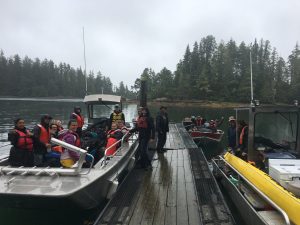
I have been on more boats in the past sixteen days than any other time during the last twenty-four years of my existence. If things go according to plan, I will have been on at least ten boats by the end of the week and hopefully more by the end of the field school. Although not totally unfamiliar with boats, the reliance on boating was a unique experience for me and has led me to reflect on two closely related concepts, landscapes and movement, and their relation to archaeological field work. In short, and perhaps surprisingly, boats have made me think about archaeology and, consequently, time differently.
Prior to our arrival on Nettle Island, we had been assigned a few readings about Barkley Sound archaeology and ethnography. These readings (particularly McKechnie 2015 and McMillan & St. Claire 2005) described pre-contact Indigenous life on the Broken Group Islands (BGIs) as being territorial wherein access to certain resources, locations, and knowledge depended on one’s cultural affiliation. Being unfamiliar with the area, I at first perceived each island as being simply another landmass within the larger archipelago. This was an oversight that was in some ways compounded by my ideas of “wild areas,” and “natural spaces” that I have inherited from romanticized notions of nature taught to me over the years and which I still find difficult to shake (cf. Cronon and “The Problem of Wilderness”). However, over the two weeks of excavation, which included a daily commute from Nettle Island to Keith Island, I had begun to become familiar with the subtle differences between the islands and water ways that connected them. My short time in the BGIs obviously pales in comparison to the more than 6,000 years of traditional knowledge and oral history developed by the Tsehaht and other First Nations who populate(d) the Barkley Sound area, but it nonetheless reified the earlier readings of socially bounded landscapes we had discussed and made me seriously question the limits of archaeological knowledge. This is to say that if it was not for the oral histories, ethnographic recordings, and living memories of the social boundaries and divisions that once characterized the BGIs, I believe it would be extremely difficult, if not impossible, to determine these aspects of the landscape from the archaeology alone.
A second, and perhaps more pragmatic, aspect of boating which left a lasting impression on me was simply how much stuff was needed to be carried to and from the docks every day. This was equipment essential to conducting archaeological excavation, our personal gear, the well-loved baked goods by our wonderful cook Wanda(!), and, among other things, people to actually put trowel to ground and make (hopefully) sound observations of what they saw. The sheer amount of things and bodies required to do archaeology in a remote region such as the BGIs came into sharp focus the last day of the field course when a classmate (Joey) and I carried the recovered artifacts for the season down to the dock to be loaded on a skiff. The entirety of our fifteen plus days of camping, cooking, dish washing, swimming, hiking, reading, talking, thinking, and (of course) excavation and inevitable backfilling, resulted in nothing more than a large ice cooler filled with bone, shellfish, and notes and a smaller tote with historic artifacts. The contrast between what we brought and what we returned with was striking and I am still wrestling with the question every archaeologist musk asks themselves: What did we just do and how can we make sense of it? Clearly archaeology is more than recovering the material remains of the past and the second half of the course will be devoted to putting things into context, or at the very least, developing some narrative from what we have found.
The UVic Field School is unique beyond its use of boats. It’s equal attention to traditional archaeological methods, pioneering approach to historical ecology, and incorporation of First Nation communities and oral histories into research is, to my knowledge, unprecedented. I sincerely thank Dr. McKechnie and Denis St. Claire for developing a field course that trains students to think (rather than dig) more deeply about the complex and intertwined relationship between humans and the environment. I know I have gained a considerable amount of insight into how to better conduct archaeological investigations as well as the importance of prioritizing living people and their unique histories when conducting research. I also sincerely thank Cody, Fred, Kevin, and the rest of the Tsehaht Beach Keepers for the wonderful opportunity to see more of the Broken Group than I would have and the Tsehaht First Nation for allowing us to study their history. Thanks also to the other field school students who have made the course an enjoyable and memorable experience.
Four boats loaded for our last voyage from Nettle to the Bamfield Marine Science Center. Not pictured is another boat that left a day earlier with the aforementioned excavated material as well as more project gear. Note the four burner oven to the right. We ate well out in the field. Thanks again Wanda!